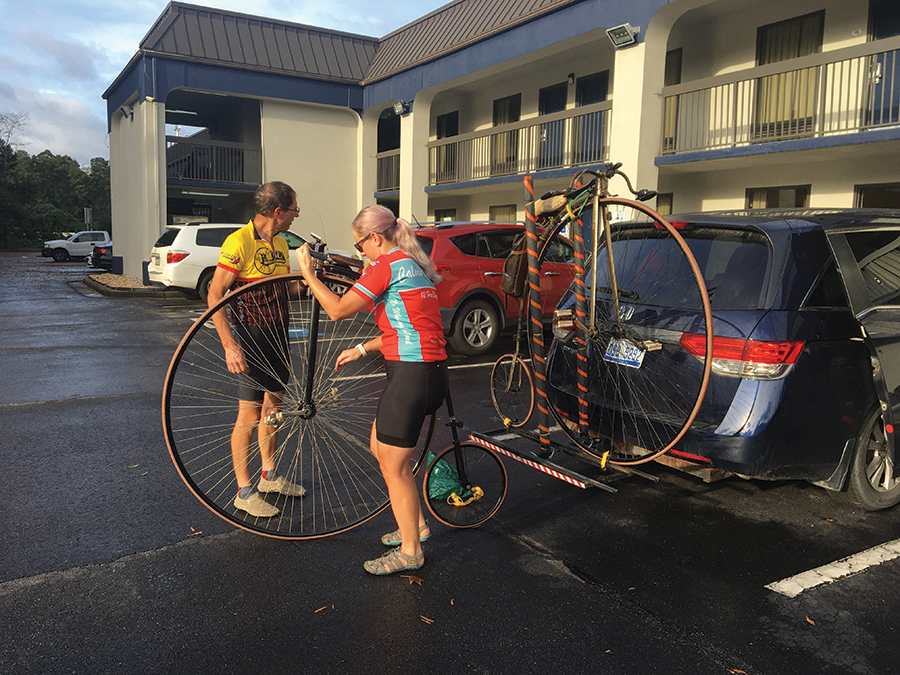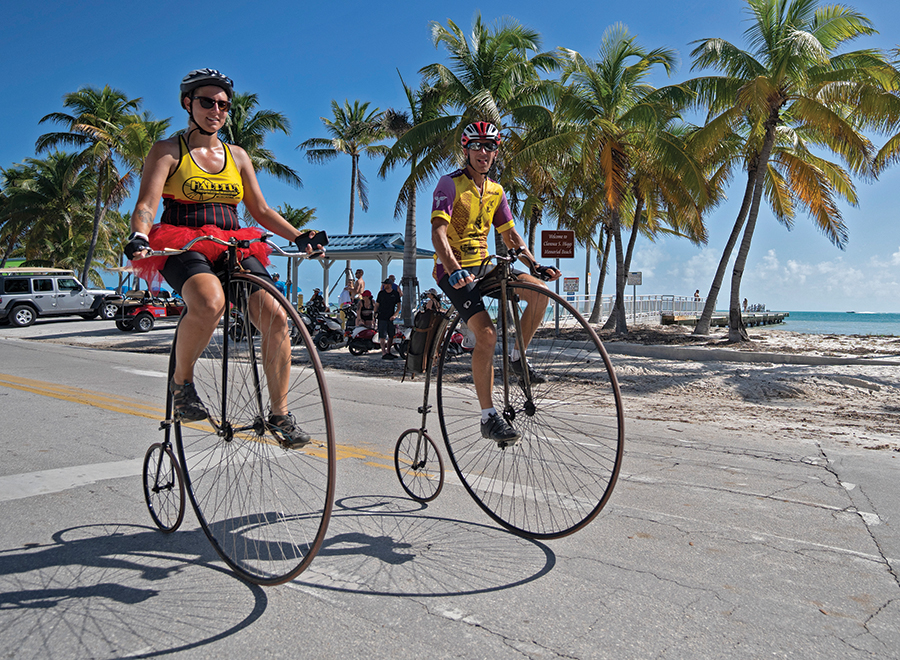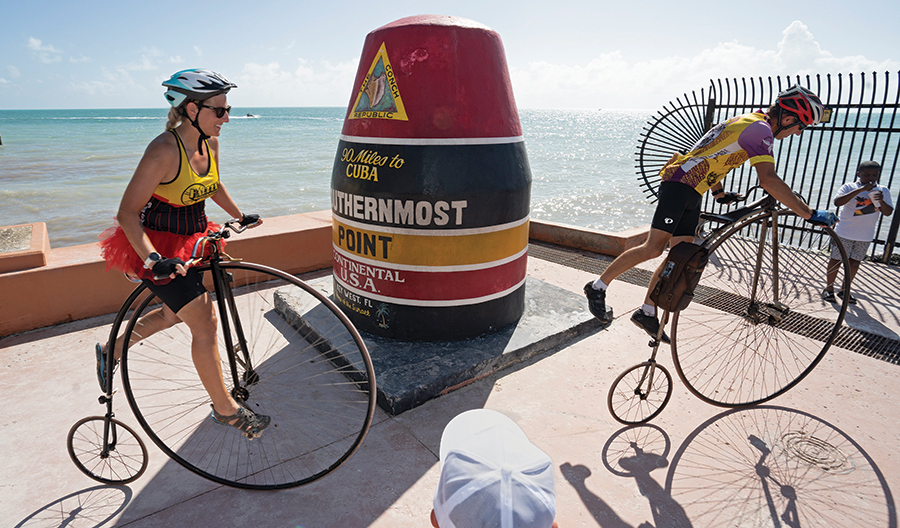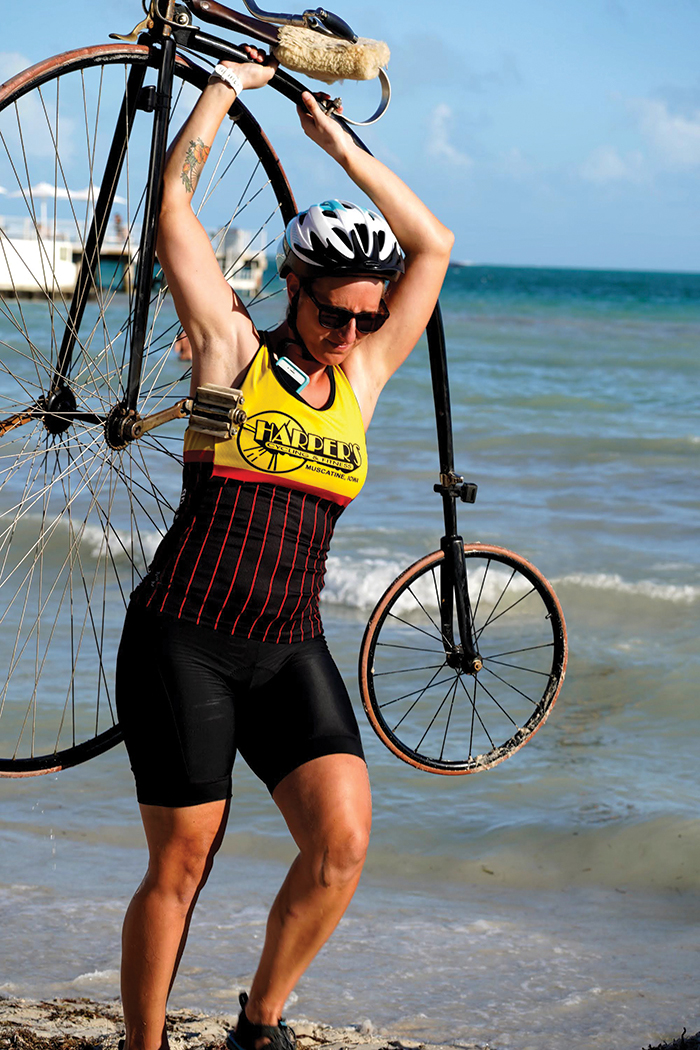Riding High
This article first appeared in the April 2021 issue of Adventure Cyclist magazine.
Even with over 45 years of riding experience between my dad and me, I was extremely nervous for our next two weeks of cycling. Our SAG wagon (my mom) was leaving us; we would be totally unsupported. My dad, Randy, was optimistic, which was good — one of us needed to be. But what if something went wrong? What if we broke down on the side of the road? After all, our bikes were over 130 years old.
My Columbia Light Roadster was built in 1888 and has a 51-inch front wheel. My dad’s has a 54 inch. These bikes are called high wheels, ordinaries, or penny farthings. You know, the bikes that Mike Wolfe on the TV show “American Pickers” loves to find? Parts must be custom made if you need to replace anything, so a bike shop can’t help you when you run into mechanical trouble. On the open road, you use a lot of grease, have Gorilla tape for backup, and pray you don’t run over anything larger than a stick. In a face-off of high wheel vs. large stick, large stick usually wins.
Riding high wheels across the country wasn’t new to us. My father and I rode from San Francisco to Boston in 2016, following in the footsteps (or tire treads) of the first cross-country rider, Thomas Stevens, who rode in 1884. Dad’s life goal was to ride across the country the original way — on a high wheel. In 2016, we were supported the whole time, which made life much easier. We learned many lessons that would help us on our 2020 journey from Sault Ste. Marie, Michigan, to Key West, Florida.
When 2020 rolled around, the trip was already two years in the making, work conflicts having pushed our ride out. We looked at the data, followed the regulations, and by the time the summer had come, we decided to still take the journey. In addition to granola bars and Aspercreme, we loaded up on face masks, hand sanitizer, and disinfectant wipes. Bike riding was deemed a COVID-safe activity. We knew we would distance ourselves from others at all times, so the trip seemed safe enough to continue. Plus, I hoped to be the first female to ride across the U.S. west to east and north to south on a high wheel.

So here we were in October 2020. All my belongings were crammed in a backpack: two pairs of clothes, tools, my iPad for work, and water, which weighed the most. My bike weighed 45 pounds and I also had to carry 10 pounds on my back. This made it more difficult to get on and off, and overall it made my body sore. Thank goodness for hot showers and ibuprofen.
Our first five days, we rode through the splashy fall foliage of northern and western Michigan. We dipped our back wheel into the St. Mary’s River, connecting to Lake Superior, to begin our lake-to-salt ride. We stayed on Mackinac Island, passed cider mills, and used smooth trails. In Grand Rapids, Dad and I strapped on our packs, said goodbye to Mom, and set out. Heading through the city was challenging — the first of many busy cities. Google Maps for bikes is made for modern-day “shorties” with pneumatic tires that can easily maneuver around. That’s not us. Stopping and getting off for us needs to be premeditated, and boy, were we tested. Sidewalks ended suddenly, and once we had to walk under a bridge that would have decapitated us.
The backroads and bike trails were where we felt most at home. As we entered Indiana, the familiar landscape of farmland greeted us. Miles and miles of corn can be boring, but they’re useful to the long-distance cyclist. The tall crops made for excellent wind blocks and emergency bathrooms.
We had our first fall near Lake Michigan. Though we are both experienced riders, the environment is always unpredictable. Seeing a parking lot with a great beach view, we pulled in for a break. Unfortunately, the layer of sand in the lot was deeper than it looked so my dad’s bike slid out from under him. His handle grip shattered, but otherwise he was fine. In 2016, we learned that Gorilla tape was the best tool to have for emergencies. We literally taped the tire to my dad’s back wheel when it came off in Wyoming. Now, we collected the pieces of the grip and roughly taped it back together too. We called Mom back at home to get another handle grip packed into the car for when she returned.
I am most aware of how tall my bike is when it rains. Rain makes the small step on the backbone for dismounting very slick. At some point, I attempted to get off my bike and slipped. I was stuck on the seat and I had run out of momentum. I felt like one of those cartoon characters after they walk over a cliff — just hanging in midair, seconds before dropping like a weight. Here I was frozen in time, unable to get off my high wheel. Then, plop. Over I went. Nothing wakes you up like falling from seven feet! But I had stuck out my leg and hung onto the handle bars, so when my foot hit the ground, the bike swung around me like a 130-year-old dance partner at a hoedown. Besides a mini heart attack, I was perfectly okay.
The silver linings in these rainy days were the socially distant visits with some Indiana Wheelmen. The Wheelmen is an international organization dedicated to collecting antique bicycles, and preserving and demonstrating cycling history. My family has been involved in the club since 1994 so we have made many friends over the years. If our path took us near fellow Wheelmen as we headed south, we would try to visit. Some even drove an hour or more to see us since we had far less mobility after dark. These brief visits lifted my spirits. I currently live in California, far away from the Midwest Wheelmen community I grew up in. Getting to see folks hadn’t seen in over five years energized me more than any Red Bull or coffee ever could. Even though we had to wear masks and elbow bump instead of hug, these visits were what sustained me mentally and emotionally. It probably was elevated even more so from being quarantined for months on end with little social interaction.

Food was our other motivation. We ride for donuts. We cycle for ice cream. We pedal for yogurt parfaits. Cruising into Jeffersonville, Indiana, we were about to be kids in a candy store. Literally. The Schimpff’s Confectionery was a local gold mine of homemade candies and a museum to candy making. The owners did a demonstration making cinnamon red hots, complete with free samples. Once they saw our bikes out front, owner Jim Schimpff brought out candy molds of various high wheel bicycles and told us their history. They also had a soda shoppe set up, and I’m lucky my dad didn’t move in right then and there. He has a fondness for all things ice cream. I think the only reason he willingly left is that Mr. Schimpff said he could come back and apprentice there to learn the techniques of the 1950’s soda jerk.
From Jeffersonville, we took the Big Four Bridge into Louisville, Kentucky. We had three Kentucky Wheelmen join us that day: Alison and Carson Torpey, and Andy Murphy, a.k.a. “Murph.” Murph set us up to interview with the local news station who met us on the top of the bridge. After our small spotlight, we were approached by two other men with a camera. They were from BBC News and in Louisville on assignment, but they saw us and wanted to get a segment as well. Sharing our story internationally was an incredible, albeit random, surprise.
Alison and Carson guided us through Louisville the next day. Alison gave us an informal tour while Carson disappeared at random. Turned out he was picking up coins he saw on the side of the road. After we left the Torpeys, Dad and I continued the trend of picking up stray money. We didn’t get off our bikes every time we saw a penny (and there were many), but we were able to collect $6.34, two Canadian dollars, and 50 pesos by the time we reached Key West! Something I learned while looking down at the street for 37 days was that there were dimes in almost every single intersection. Why it’s always dimes will forever remain a mystery to me.
Slow cruising had its perks besides collecting money. We don’t race past the scenery since we go 10 MPH on a good day, 8 MPH on a bad day. We could fully enjoy the cows staring at us, woolly bear caterpillars wiggling into the street, various landscape designs of homes and their Halloween decorations. Some towns were so small, without any gas stations or stores, yet plenty of dogs to chase us. We did find some hidden gems, like authentic backroad BBQ and local bakeries.
Kentucky and Tennessee brought us into the hills. It was sad to say goodbye to the rail trails, but at least I wouldn’t get hit in the head with branches. (Trail groomers don’t trim trees for high wheel heights.) Because high wheels are fixed gear, you have to crank as hard as you can to get up a hill. You can’t stand on your pedals to get momentum, but you can pull on your handlebars to get some opposing torque. Once I hit 5 MPH, I know it’s time to get off my bike or risk falling over. Downhills are far more fun but can be dangerous. High wheels have basically no brakes. You just have to backpedal. We have spoon brakes that push down on the front wheel, but they’re not very strong. You have to make a judgement call if a hill is too steep to go down. But if it looks safe and there’s no stop sign at the bottom, you can take your feet off the pedals and coast down. I hit 26 MPH on a few of them bad boys myself.

No great adventure is complete without a few more twists and turns. Most issues came from using Google Maps. Farm roads disappeared, turned to sand, or didn’t exist at all. Google Street View became our go-to resource, since we could see exactly what roads were made out of. High wheels and loose gravel do not mix well. Construction also popped up, and even though one bridge was out for over a year, the app said we could cross it. Lucky for us, the bridge was almost complete and the crew let us walk through. Locals helped us out as well, some cyclists even finding us on the street to ask about our trip, and giving us good directions.
Meeting the locals was dad’s favorite. High wheel bikes are eye-catching, so no matter where we stopped, people came to talk to us. They asked us the typical questions. “How do you get on?” “Where did you get it?” “Are you crazy?” The only problem was when people were in cars. Some people tried to talk to us or, worse, take photos while driving. I had a car come within inches of me because they swerved while trying to take my picture! Looky loos can also cause traffic congestion, much to other drivers’ annoyance. But what do you expect when we look like we’re bringing the circus to town?
Somehow the two weeks without our SAG flew by. When Mom returned, it couldn’t have been better timing. Each day we rode south grew warmer, so all the layers we had packed weighed us down. Hurricane Eta had also hit the U.S. Who knew that, on top of COVID-19, the U.S. would experience an above-average hurricane season? Storms blew our way, slowing us down. With our custom bike rack on Mom’s van, she was able to pick us up and drop us off at our end/start points. We also had more food and clothing options, as well as my laptop. It was faster to do my remote work and write my daily travel blog on a laptop rather than an iPad.
Georgia inspired us to make a bucket list featuring Southern food: fried chicken, peach cobbler, and moon pies. Strangely, we were not able to find much, largely due to COVID shutting down small businesses. On one of our last days in the Peach State, a car stopped next to us in a parking lot. A woman got out and introduced herself as someone from our very small hometown, Carleton. Turns out Dad knew her family and they went to the same high school back in the day.
She lived in the next town over, read our blog, and decided to find us on the road because she had some very special treats for us. She read that we couldn’t find moon pies on our “food bucket list” so she bought some, as well authentic Georgia peanuts, satsuma oranges from her backyard, and some cotton puffs for souvenirs. To have someone get up early and go out of their way to do something that nice for us was incredibly humbling and heartwarming. The moon pies were also delicious.
Hitting that Georgia-Florida state line felt like reaching the finish line itself. Though we unknowingly had 11 more days ahead of us, I could feel our victory inching closer. The warm weather and tropical plants added to the excitement. We found bike trails that helped avoid the logging trucks, and on the first path, we came across a bike club that gave us helpful directions. When we stopped to look at our first ’gator on that same bike path, we met some lovely ladies, one of whom had a golden conure bird in a sweet little travel backpack. His name was Bebop, and I loved him.
Getting to see the ocean, I could have gladly stopped there. Route A1A went by the boardwalk, and my heart was glowing. Basking in the sun and seeing the surf was a dream. I quickly learned I had to snap out of it and look down because there were iguanas everywhere. They waddled as fast as they could, like little cowboys. We ended up leaving A1A due to it being too narrow, but the iguanas were still plenty.
One of my favorite moments was reaching Daytona Beach. Dad and I went body surfing while Mom searched for shells. One Florida Wheelman suggested that we ride our bikes on the beach itself, which of course we did. The hard-packed sand was far better than the quicksand in the parking lot far, far away in Indiana.
Hurricane Eta wasn’t done yet. Roads were flooded, forcing us to reroute. Two stormy days had us barely getting 40 miles in a day. Finally, Eta exhausted itself and it was prime weather for entering the Keys. Over countless bridges we went, keeping an eye out for manatee and alligators. Being in the Keys felt more like a vacation than work. We fed giant tarpon fish at Robbie’s pier, which I had to be persuaded into doing since it required holding a dead fish. We swam in motel pools, had fresh seafood, and saw tiny Key deer on Big Pine Key.

Our last day of riding was pure celebration. Do you remember Murph from Kentucky? His stepdaughter, Destiny, lives in Key West. She heard about our trip and rallied the Key West Bike Club to meet us. We had a police escort through Key West, followed by the bike club, and another TV crew came to film. As we turned a corner, we saw the famous Key West buoy, marking the southernmost part of the U.S. The tourists who were there for their own photos cheered as they saw us coming. It was surreal, getting to parade into town and have a warm reception, as if we had crossed an actual finish line.
The buoy wasn’t our last stop though. We found the famous green 0-mile marker and, lastly, dipped our front wheels into the Atlantic Ocean to bookend our lake-to-salt ride. Beachgoers looked confused as we carried our bikes across the sand, but that hardly mattered. After 37 days, we had made it, and I had reached my goal of being the first female high wheeler to travel west–east and north–south!
The day after our victory, we celebrated in true cycling fashion — by going on another bike ride. This slow roll of 10 miles was special. It was with the Key West Bike Club! Leading the way in their iconic red shirts, we moseyed around the streets dotted with free-roaming chickens, getting our own historical tour by local tour guide Bruce. He even gave us our own red Bike Club shirts, so we’re truly inducted into the group!
While each state brought us new challenges, local foods, and sore muscles, we could always count on one thing: everyone wanted to know if we watched “American Pickers.” It also gave me some great tan lines to take home for the winter. But my favorite thing it brought me was being closer to my dad and mom, and those memories will last longer than the tan lines.

